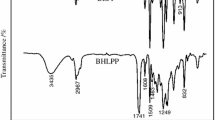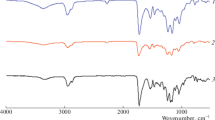Abstract
Macromolecular diols with different carbamate content were synthesized by alterative n(PPG)/n(HMDI) ratio. The molecular weights of these macromolecular diols were measured by GPC. In addition, based on these macromolecular diols, waterborne polyurethanes (WPU) were prepared by the pre-polymerization method. The structure and molecular weight of the WPU were characterized by 1HNMR, FTIR and GPC, respectively. When the mole ratio of n(PPG) and n(HMDI) decreased, the particle distribution of WPU became broader and the average particle size became larger. Furthermore, the hydrogen bonding interaction in WPU films was analyzed by the deconvolution of amino, carbonyl band and ether band of FTIR spectra. The results showed that when introduced carbamate into the macromolecular diol, the ordered hydrogen bonding interaction in hard segments increased and the interaction between carbamate and ether occurred. The increased hydrogen bonding interaction leads to the higher micro-phase separation confirmed by AFM and DSC test. Carbamate in soft segments can significantly increase the modulus of WPU in the whole temperature range. Meanwhile, the tensile strength and the elongation at break were obviously increased when introduced carbamate into the soft segments because of the crosslinked structure and micro-phase separation morphology. The tensile strength of sample WPU1 caught 28.28 MPa which was 2.37 times and the elongation at break caught 911% which was 2.18 times than that of WPU0.










Similar content being viewed by others
References
Cheng D, Wen YB, An XY, Zhu XH, Ni YH (2016) TEMPO-oxidized cellulose nanofibers (TOCNs) as a green reinforcement for waterborne polyurethane coating (WPU) on wood. Carbohydr Polym 151:326–334
Wang J, Zhang HM, Miao YY, Qiao LJ, Wang XH (2017) A whole-procedure solvent-free route to CO2-based waterborne polyurethane by an elevated-temperature dispersing strategy. Green Chem 19(9):2194–2200
Jeong JH, Han YC, Yang JH, Kwak DS, Jeong HM (2017) Waterborne polyurethane modified with poly (ethylene glycol) macromer for waterproof breathable coating. Prog Org Coat 103:69–75
Lei L, Xia ZB, Zhang L, Zhang YH, Zhong L (2016) Preparation and properties of amino-functional reduced graphene oxide/waterborne polyurethane hybrid emulsions. Prog Org Coat 97:19–27
Hu L, Jiang PP, Zhang PB, Bian G, Sheng SS, Huang M, Bao YM, Xia JL (2016) Amine–graphene oxide/waterborne polyurethane nanocomposites: effects of different amine modifiers on physical properties. J Mater Sci 51(18):8296–8309. https://doi.org/10.1007/s10853-016-9993-5
Fatemeh F, Khorasani M, Ebrahimi M (2017) Improving the mechanical properties of waterborne nitrocellulose coating using nano-silica particles. Prog Org Coat 109:110–116
Xiao Y, Jiang L, Liu ZM, Yuan Y, Yan PY, Zhou CL, Lei JX (2017) Effect of phase separation on the crystallization of soft segments of green waterborne polyurethanes. Polym Test 60:160–165
Reche JAJ, Pacios VG, Costa V, Colera M, Martínez JMM (2015) Role of the interactions between carbonate groups on the phase separation and properties of waterborne polyurethane dispersions prepared with copolymers of polycarbonate diol. Prog Org Coat 88:199–211
Cakić SM, Ristić IS, Cincović MM, Špírková M (2013) The effects of the structure and molecular weight of the macrodiol on the properties polyurethane anionic adhesives. Int J Adhes Adhes 41:132–139
Cakić SM, Špírková M, Ristić IS, B-Simendić JK, M-Cincović M, Poręba R (2013) The waterborne polyurethane dispersions based on polycarbonate diol: effect of ionic content. Mater Chem Phys 138(1):277–285
Ayres E, Orefice RL, Yoshida MI (2007) Phase morphology of hydrolysable polyurethanes derived from aqueous dispersions. Eur Polym J 43(8):3510–3521
Wang L, Shen YD, Lai XJ, Li ZJ, Liu M (2011) Synthesis and properties of crosslinked waterborne polyurethane. J Polym Res 18(3):469–476
Santamaria-Echart A, Arbelaiz A, Saralegi A, Fernández- d’Arlas B, Eceiza A, Corcuera MA (2015) Relationship between reagents molar ratio and dispersion stability and film properties of waterborne polyurethanes. Colloids Surf A 482:554–561
Hwang HD, Park CH, Moon JI, Kim HJ, Masubuchi T (2011) UV-curing behavior and physical properties of waterborne UV-curable polycarbonate-based polyurethane dispersion. Prog Org Coat 72(4):663–675
García-Pacios V, Jofre-Reche JA, Costa V, Colera M, Martín-Martínez JM (2013) Coatings prepared from waterborne polyurethane dispersions obtained with polycarbonates of 1,6-hexanediol of different molecular weights. Prog Org Coat 76(10):1484–1493
Lee YM, Lee JC, Kim BK (1994) Effect of soft segment length on the properties of polyurethane anionomer dispersion. Polymer 35(5):1095–1099
Kim BK, Yang JS, Yoo SM, Lee JS (2003) Waterborne polyurethanes containing ionic groups in soft segments. Colloid Polym Sci 281(5):461–468
Santamaria-Echart A, Fernandes I, Saralegi A, Costa MRPFN, Barreiro F, Corcuera MA, Eceiz A (2016) Synthesis of waterborne polyurethane-urea dispersions with chain extension step in homogeneous and heterogeneous media. J Colloid Interface Sci 476:184–192
Ren ZY, Ma DZ, Yang XZ (2003) H-bond and conformations of donors and acceptors in model polyether based polyurethanes. Polymer 44(20):6419–6425
García-Pacios V, Costa V, Colera M, Martín-Martínez JM (2010) Affect of polydispersity on the properties of waterborne polyurethane dispersions based on polycarbonate polyol. Int J Adhes Adhes 30(6):456–465
Lee J, Kim M, Hong CK, Shim SE (2007) Measurement of the dispersion stability of pristine and surface-modified multiwalled carbon nanotubes in various nonpolar and polar solvents. Meas Sci Technol 18(12):3707–3712
Lee HT, Hwang JJ, Liu HJ (2006) Effects of ionic interactions between clay and waterborne polyurethanes on the structure and physical properties of their nanocomposite dispersions. J Polym Sci, Part A: Polym Chem 44(19):5801–5807
Liu N, Zhao YH, Kang MQ, Wang JW, Wang XK, Feng YL, Yin N, Li QF (2015) The effects of the molecular weight and structure of polycarbonatediols on the properties of waterborne polyurethanes. Prog Org Coat 82:46–56
Yeh JM, Yao CT, Hsieh CF, Lin LH, Chen PL, Wu JC, Yang HC, Wu CP (2008) Preparation, characterization and electrochemical corrosion studies on environmentally friendly waterborne polyurethane/Na+-MMT clay nanocomposite coatings. Eur Polym J 44(10):3046–3056
Pérez-Limiñana MA, Arán-Aís F, Torró-Palau AM, Orgilés-Barceló AC, Martín-Martínez JM (2005) Characterization of waterborne polyurethane adhesives containing different amounts of ionic groups. Int J Adhes Adhes 25(6):507–517
Prabhakar A, Chattopadhyay DK, Jagadeesh B, Raju KVSN (2005) Structural investigations of polypropylene glycol (PPG) and isophorone diisocyanate (IPDI)-based polyurethane prepolymer by 1D and 2D NMR spectroscopy. J Polym Sci, Part A: Polym Chem 43(6):1196–1209
Rahman MM, Kim EY, Kwon JY, Yoo HJ, Kim HD (2007) Cross-linking reaction of waterborne polyurethane adhesives containing different amount of ionic groups with hexamethoxymethyl melamine. Int J Adhes Adhes 28(1):47–54
Pavličević J, Špírková M, Bera O, Jovičić M, Pilić B, Baloš S, Budinski-Simendić J (2014) The influence of ZnO nanoparticles on thermal and mechanical behavior of polycarbonate-based polyurethane composites. Compos Part B Eng 60:673–679
Mishra AK, Chattopadhyay DK, Sreedhar B, Raju KVSN (2006) FT-IR and XPS studies of polyurethane-urea-imide coatings. Prog Org Coat 55(3):231–243
Špírková M, Pavličević J, Strachota A, Poreba R, Bera O, Kaprálková L, Baldrian J, Šlouf M, Lazić N, Budinski-Simendić J (2011) Novel polycarbonate-based polyurethane elastomers: composition-property relationship. Eur Polym J 47(5):959–972
Wen TC, Wu MS, Yang CH (1999) Spectroscopic investigations of poly (oxypropylene) glycol-based waterborne polyurethane doped with lithium perchlorate. Macromolecules 32(8):2712–2720
Mattia J, Painter P (2007) A comparison of hydrogen bonding and order in a polyurethane and poly(urethane-urea) and their blends with poly(ethylene glycol). Macromolecules 40(5):1546–1554
Digar M, Hung SL, Wang HL, Wen TC, Gopalan A (2002) Study of ionic conductivity and microstructure of a cross-linked polyurethane acrylate electrolyte. Polymer 43(3):681–691
Chiu CY, Hsu WH, Yen YJ, Kuo SW, Chang FC (2005) Miscibility behavior and interaction mechanism of polymer electrolytes comprising LiClO4 and MPEG-block-PCL copolymers. Macromolecules 38(15):6640–6647
Santhosh P, Vasudevan T, Gopalan A, Lee KP (2006) Preparation and properties of new cross-linked polyurethane acrylate electrolytes for lithium batteries. J Power Sources 160(1):609–620
Hong L, Shi LY, Tang XZ (2003) Conductivities and spectroscopic studies of polymer electrolytes based on linear polyurethane and hybrid and copolymer of linear and hyperbranched polyurethanes. Macromolecules 36(13):4989–4994
Król P (2007) Synthesis methods, chemical structures and phase structures of linear polyurethanes. Properties and applications of linear polyurethanes in polyurethane elastomers, copolymers and ionomers. Prog Mater Sci 52:915–1015
Kojio K, Kugumiya S, Uchiba Y, Nishino Y, Furukawa M (2009) The microphase-separated structure of polyurethane bulk and thin films. Polym J 41(2):118–124
Schön P, Bagdi K, Molnár K, Markus P, Pukánszky B, Vancso GJ (2011) Quantitative mapping of elastic moduli at the nanoscale in phase separated polyurethanes by AFM. Eur Polym J 47:692–698
Zheng JR, Ozisik R, Siegel RW (2006) Phase separation and mechanical responses of polyurethane nanocomposites. Polym 47:7786–7794
Corcuera MA, Rueda L, d’Arlas BF, Arbelaiz A, Marieta C, Mondragon I, Eceiza A (2010) Microstructure and properties of polyurethanes derived from castor oil. Polym Degrad Stab 95:2175–2184
Gao RL, Zhang MQ, Dixit N, Moore RB, Long TE (2012) Influence of ionic charge placement on performance of poly (ethylene glycol)-based sulfonated polyurethanes. Polymer 53(6):1203–1211
Lu YS, Larock RC (2008) Soybean-oil-based waterborne polyurethane dispersions: effects of polyol functionality and hard segment content on properties. Biomacromol 9(11):3332–3340
Cao XD, Habibi Y, Lucia LA (2009) One-pot polymerization, surface grafting, and processing of waterborne polyurethane-cellulose nanocrystal nanocomposites. J Mater Chem 19(38):7137–7145
Pan HX, Chen DJ (2007) Preparation and characterization of waterborne polyurethane/attapulgite nanocomposites. Eur Polym J 43(9):3766–3772
Kim BK, Lee SY, Baek SH, Choi YJ, Lee JO, Xu M (1998) Polyurethane ionomers having shape memory effects. Polymer 39(13):2803–2808
Wu JR, Chen DJ (2006) Synthesis and characterization of waterborne polyurethane based oncovalently bound dimethylol propionic acid to e-caprolactone based polyester polyol. Prog Org Coat 97:203–209
Santos CC, Delpech MC, Coutinho FMB (2009) Thermal and mechanical profile of cast films from waterborne polyurethanes based on polyether block copolymers. J Mater Sci 44(5):1317–1323. https://doi.org/10.1007/s10853-009-3272-7
Trovati G, Sanches EA, Neto SC, Mascarenhas YP, Chierice GO (2010) Characterization of polyurethane resins by FTIR, TGA, and XRD. J Appl Polym Sci 115(1):263–268
Fu HQ, Wang Y, Li XY, Chen WF (2016) Synthesis of vegetable oil-based waterborne polyurethane/silver-halloysite antibacterial nanocomposites. Compos Sci Technol 126:86–93
Acknowledgements
The project was financed by the National 863 Project (No. 2015AA033903).
Author information
Authors and Affiliations
Corresponding author
Electronic supplementary material
Below is the link to the electronic supplementary material.
Rights and permissions
About this article
Cite this article
Tao, C., Luo, Z., Bao, J. et al. Effects of macromolecular diol containing different carbamate content on the micro-phase separation of waterborne polyurethane. J Mater Sci 53, 8639–8652 (2018). https://doi.org/10.1007/s10853-017-1908-6
Received:
Accepted:
Published:
Issue Date:
DOI: https://doi.org/10.1007/s10853-017-1908-6




